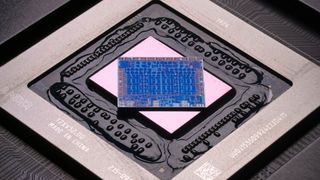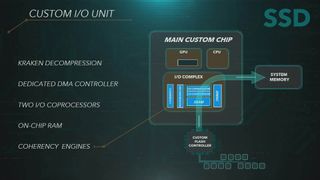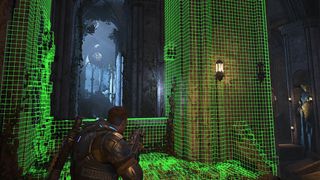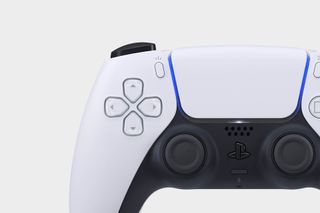The Xbox Series X and PS5 features coming to a gaming PC near you
Even your PC will benefit from the next generation of game console technology.

There's a lot to be excited about with the next-gen consoles, and not the least bit is how they will bolster our gaming PCs. Both the next-gen Xbox Series X and Sony's PlayStation 5 share a genetic code with PC hardware that in some cases goes right down to the metal, and that's why the upcoming relationship between PC and next-gen console could be more beneficial than ever before.
Both the Xbox Series X and PlayStation 5 operate with AMD-designed technology at their gooey centres—AMD Zen 2 and RDNA 2 chips to be precise. Both consoles have opted for the much more current technology this time around—a far cry from the quickly outdated silicon that used to line the innards of the previous generation.
Their counterparts are now available within the PC ecosystem, too. Ryzen 3000 processors left their mark on the best CPUs for gaming list, thanks in large part to the AMD Zen 2 architecture and remain excellent chips even with the arrival of the hot new Ryzen 5000-series powered by Zen 3. As for RDNA 2.0 graphics cards, they're due out shortly in the form of the AMD Radeon RX 6000 family of GPUs.
What separates console from console are the many proprietary or pseudo-proprietary features being integrated at the nanometre level. Sony is rolling out its own 3D audio algorithms, uber-high bandwidth I/O, and SSD controller with the PS5. While Microsoft is bringing its 'Xbox Velocity Architecture' to bear with its latest console, which will also be fitted with all the advancements introduced within the flashy DirectX 12 Ultimate API.
Where things get interesting for us PC folk is when these many advancements intersect our not-so-humble hobby, and many of the features within both Microsoft and Sony's secret sauce are not as proprietary as they'd like to have us believe. In fact, many of the features touted for next-gen consoles will make it to our gaming PCs at some point or another. So let's take a look at what's coming.

Graphics
Ray tracing. That's been the graphical buzzword for the past two years in PC hardware and it's soon set to take the console world by storm, too. Both the Xbox Series X and PlayStation 5 will offer ray tracing in one form or another, powered by the AMD RDNA 2 graphics architecture.
| Header Cell - Column 0 | Xbox Series X specs | PS5 specs |
|---|---|---|
| CPU | AMD Zen 2 CPU | AMD Zen 2 CPU |
| CPU core count | 8 | 8 |
| CPU clock speed | 3.8GHz (3.66GHz w/ SMT for 16 threads) | 3.5GHz |
| GPU | AMD RDNA 2 | AMD RDNA 2 |
| Compute units | 52 | 36 |
| GPU clock speed | 1.825GHz | 2.23GHz |
| Memory | 16GB GDDR6 | 16GB GDDR6 |
| Storage | 1TB NVMe SSD | 825GB NVMe SSD |
| Optical drive | 4K Ultra HD Blu-ray | 4K Ultra HD Blu-ray |
Until now, the ray tracing ecology has been resolutely green on PC. That is, entirely Nvidia-dependent. But with the release of the next-gen consoles and their AMD Radeon RX 6000 PCIe add-in card counterparts, there's a new player in town.
The biggest gaming news, reviews and hardware deals
Keep up to date with the most important stories and the best deals, as picked by the PC Gamer team.
There's a lot more to be excited about with the RDNA 2 architecture, too. During an architecture deep-dive, Sony's Mark Cerny confirmed that we'll find a lot of similarities between the custom technology it is introducing with the PS5 and AMD's new lineup of RDNA 2 'Navi 2X' graphics cards, now known as the Radeon RX 6900 XT, RX 6800 XT, and RX 6800.
“AMD is continuously improving and revising their tech,” says Cerny. “For RDNA 2, their goals were, roughly speaking, to reduce power consumption by architecting the GPU to put data where it’s needed, to optimise the GPU for performance, and to add a new, more advanced feature set.
"But that feature set is malleable, which is to say we have our own needs for PlayStation and that can factor into what the AMD roadmap becomes. So collaboration is formed. If we bring concepts to AMD that are felt to be widely useful, then they can be adopted into RDNA 2 and used broadly, including PC GPUs. If the ideas are sufficiently specific to what we’re trying to accomplish, like the GPU cache scrubbers I was talking about, then they end up being just for us. If you see a similar discrete GPU available as a PC card at roughly the same time as we release our console, that means our collaboration with AMD succeeded in producing technology in both worlds. It doesn’t mean we simply incorporated a PC part into our console.”
There are some features you won't find in AMD's Navi 2X lineup of graphics cards, such as the cache scrubbers that Cerny alludes to. These are one of the few custom tweaks to the GPU component that Sony detailed during its architecture deep-dive stream, and it sounds like we'll not be seeing Sony's scrubbers anytime soon. Shame.
However, now that RDNA 2 has been revealed in desktop PC form, we can confirm that the vast majority of graphical features are indeed included. What's more, The Radeon RX 6000 scales up to fully 80 compute units in the 6900 XT. Even the entry-level Radeon 6800, albeit a $549 graphics card, packs 60 compute units to the 52 and 36 units of the Xbox Series X and PS5, respectively. In other words, RDNA 2 for PC is just like RDNA 2 in console, there's just even more of it.
Another AMD technology coming to the PS5 is SmartShift. It dynamically shifts the power budget of the system between the GPU and CPU, ensuring that the system remains in its power envelope without needlessly limiting performance. Lucky for you, that's also available across gaming laptops with Radeon dGPUs and AMD's Ryzen 4000 APUs.
We've also seen a tech demo for the PlayStation 5 which offers a glimpse into another aspect of the future of RDNA 2 graphics. Epic Games' Unreal Engine 5 tech demo, Lumen in the Land of Nanite, introduced two key technologies: Lumen and Nanite. These aim to shift some of the workload associated with assets and pre-baked lighting away from developers and onto the engine itself, and aims to tackle how an engine deals with assets of film grade usually deemed far too complex for most systems to handle.
- Nanite allows developers to import highly-detailed assets directly into games without worrying about system demand. Usually asset LODs or normal maps are required to make a game look more detailed than it is, and those require manual work to implement. With Nanite, these can be bypassed, allowing devs to spend more time crafting beautiful assets knowing that the Unreal Engine will stream and scale these in real-time to fit the current requirements or system budgets.
- Lumen is a dynamic global illumination technology that treads similar ground to global illumination powered by hardware-accelerated real-time ray tracing. It's worth noting that this is not hardware accelerated in the UE5 demo, but that is possible with the PS5's RDNA 2 GPU. The system actively and dynamically shifts indirect and diffused lighting to match the scene, which offers a lot of freedom and flexibility for day and night cycles or realistic lighting from player interactions beyond what is possible with 'pre-baked', or hard-coded and static, lighting.
Despite being a PlayStation 5 tech demo, the Unreal Engine remains as platform-agnostic as ever. Our own Tyler Wilde spoke with Epic Games CTO Kim Libreri, who reassured him that an RTX 2070 Super would get "pretty good" performance in the demo, so you can be sure your gaming PC will be up to scratch when the first wave of games using Lumen and Nanite are released.
The primary takeaway from this demo—and it's important to contextualise that demo for what it is, a glimpse of what could be with today's technology—is the potential for further implementations of these cross-platform asset streaming technologies in line with the storage technologies we'll be diving into next, how these could affect how we build our future gaming PCs and what components we decide to use, and even how these components are designed.

Storage
Crucial to both the Playstation 5 and Xbox Series X is the inclusion of an NVMe drive, which have already found a home in the latest gaming PCs. Most of the best gaming motherboards support at least a handful of super-speedy NVMe SSDs as standard today.
Both Microsoft and Sony are including custom I/O and compression technologies in order to increase system bandwidth. Streamlining and optimising asset streaming is a common thread across console and engine development in 2020, with UE5 also "optimised for next-generation storage".
For the Xbox Series X, Microsoft is offering the new Xbox Velocity Architecture to help its console along. It's actually composite of a four key technologies—DirectStorage, a custom NVMe SSD, Sampler Feedback Streaming, and a dedicated decompression block—of which at least half are also coming to gaming PCs—in fact, a few are already in the works right now.
DirectStorage, as a member of the DirectX family of products, is a brand new I/O system that aims to reduce CPU overhead from a multi-core workload to a sliver of a single core. That's a common theme across both next-gen consoles by the way: reducing CPU load to a fraction of what it once was. Microsoft plans to bring DirectStorage onto the Windows platform as well as the Xbox Series X, which will also see Intel CPUs benefit.
The new I/O API also works in tandem with the console's increased bandwidth to free up CPU operations for other important tasks. That's especially important on a console that is often running at a lower clock speed than an equivalent high-end desktop counterpart, but will nonetheless prove itself a rising tide that lifts all boats from budget gaming to enthusiast-class systems so long as developers put it to good use. The good news is that DirectStorage is supported on both Nvidia's latest RTX 3000 series GPUs and AMD's recently announced Radeon RX 6000 family. So, in that regard, if not the Xbox's dedicated decompression block, the PC is a match for consoles.
Sampler Feedback Streaming (SFS) is another tool that's actually already in the developer toolbox on PC, although not one you'll likely have come into contact with all that often. It focuses on improving texture streaming and texture-space shading, which both serve to improve rendering at high resolutions with the utmost fidelity without hogging all the system resources for this single task.
For RDNA 2, their goals were to reduce power consumption by architecting the GPU to put data where it’s needed, to optimise the GPU for performance, and to add a new, more advanced feature set.
Mark Cerny
The reason that might sound familiar is because SFS is included in the Direct X 12 Ultimate API, which recently received its first developer-friendly drivers from Nvidia as a primer for a wider rollout in the next wave of games currently in development. DX12 U also includes DirectX Raytracing, variable rate shading, and mesh shaders. It's an API for a new generation of games, one piece of the next-gen puzzle, and is certified compatible with hardware from both Nvidia and AMD—so you can count on its full support on PC.
On the flip side, the PlayStation 5 can't operate DX12 or any part of Microsoft's API, for obvious reasons. Instead we'll find the similarities here lie within the custom system-on-chip that AMD produced with Sony for the PlayStation. You see, while both the Xbox and PlayStation both operate similar RDNA 2 graphics silicon, they are configured very differently.
Sony's custom chip integrates a custom I/O complex to once again deliver unprecedented console bandwidth. It's including a hardware decompression chip, much like the Series X, along with a dedicated DMA controller, two I/O co-processors, coherency engines, and those proprietary GPU cache scrubbers I spoke about earlier. Perhaps the biggest difference between the two consoles, and our gaming PCs, is that Sony has designed its very own flash controller for its onboard SSD. That's unlike anything we've got on PC right now, and we'll have to see how it stacks up next to the best PCIe 4.0 controllers in terms of raw bandwidth.
So all this stuff about decompression makes it sound like that's going to be a real focus for future game development and performance. So what about on PC? Well, we might see a lot more of that technology make its way into our PC components, such as improved I/O capabilities on-chip. A high-bandwidth cache was something AMD lightly touched upon with its Vega architecture and with the Radeon RX 6000 series, it has introduced 128MB of new fangled 'Infinity Cache' in every GPU. It's essentially a local on-die GPU cache that buffers against traffic to the main memory, reducing the need to access data in VRAM over the GPU's memory bus.
Another related technology for the PC from AMD is Smart Access Memory. Only available when pairing AMD's new Ryzen 5000 CPUs with its latest RX 6000 GPUs, Smart Access Memory expedites access to GPU memory for the CPU. In conventional Windows-based PC systems, processors can only access graphics memory (VRAM) in 256MB chunks, limiting system performance. With AMD Smart Access Memory, the data channel is expanded to allow access to the entire VRAM at once, removing a significant bottleneck to performance.
Exactly how the PC will compare to the new consoles in terms of overall bandwidth and data transfer isn't yet clear. But both system IO, memory bandwidth and storage performance are becoming increasingly important across all platforms, that for sure. Epic Games, for instance, is suggesting that fast SSD storage is pivotal to the whole tech demo, and that the PS5's storage solution is "god-tier" while the PC's is just okay. But how much will a HDD or slower SATA SSD slow you down? Will the demands for memory creep up as greater capacity is required to store larger textures in waiting?
There are a lot of questions surrounding to what extent an SSD, or lack thereof, will impact gaming performance. And something tells me it's not going to be a simple case of fast SSD=higher fps. One thing we do know for sure is that console users will be able to experience the rapid boot, lack of loading screens, and cut-down texture pop-in that almost any SSD delivers as a result of faster read/write speeds over a traditional HDD. And perhaps we'll find that on PC we see a greater push into GPU I/O and caching come the next generation.

Audio
Onto audio, and I promise this one's not quite so lengthy. Gaming PCs have long been capable of 3D and spatial audio, such as HRTF processing, and it's often enabled on a per game level. That's something most often offloaded to the CPU, unless accelerated by dedicated chips within our headsets or DACs (digital-to-analogue converters).
The Xbox Series X features a dedicated audio block intended to process sound in fine detail and with more complex algorithms, under the Project Acoustics banner. It will also feature plug-in support for Unity and the Unreal engine.
What's potentially of interest to PC gamers, with the release of the PlayStation 5, is the inclusion of a new 3D audio engine built out of a repurposed GPU Compute Unit (CU).
Sony aims to deliver spatial and HRTF processing without burdening the CPU anymore than it should. The algorithms it plans on introducing with its Tempest 3D AudioTech package are Sony's own creation, but it was careful not to call the engine itself proprietary. That says to me we're likely to find a lot of similarities between the Sony and AMD in terms of pseudo-proprietary audio engines under either the PlayStation or Radeon banner.

What else can we expect on PC from the next-gen consoles? Well, both the Sony DualSense controller and the redesigned Xbox controller will almost certainly work with our gaming PCs at some point. Arguably the DualSense may require a little more fiddling, but so long as neither requires a dongle, I'm down.
Otherwise it's all looking quite rosy for gaming PC and console cross-pollination for the next generation of games. That should serve to improve the gaming experience across the board. Of course, there's one potential hitch in the plan, and that's developer support.
This isn't our first rodeo with proprietary AMD features that look great on paper but don't quite pan out in person. Still, AMD RDNA 2 really is only the tip of the iceberg when it comes to console and PC gaming going forward, and brand new consoles do wonders for convincing developers to adopt new-age functionality that they might not have otherwise considered, such as ray tracing or advanced audio algorithms.
And hey, if only half of the new features in both the new consoles and game engines make it to the mainstream, we're in for a good time on PC, too.

Jacob earned his first byline writing for his own tech blog. From there, he graduated to professionally breaking things as hardware writer at PCGamesN, and would go on to run the team as hardware editor. He joined PC Gamer's top staff as senior hardware editor before becoming managing editor of the hardware team, and you'll now find him reporting on the latest developments in the technology and gaming industries and testing the newest PC components.
Most Popular

